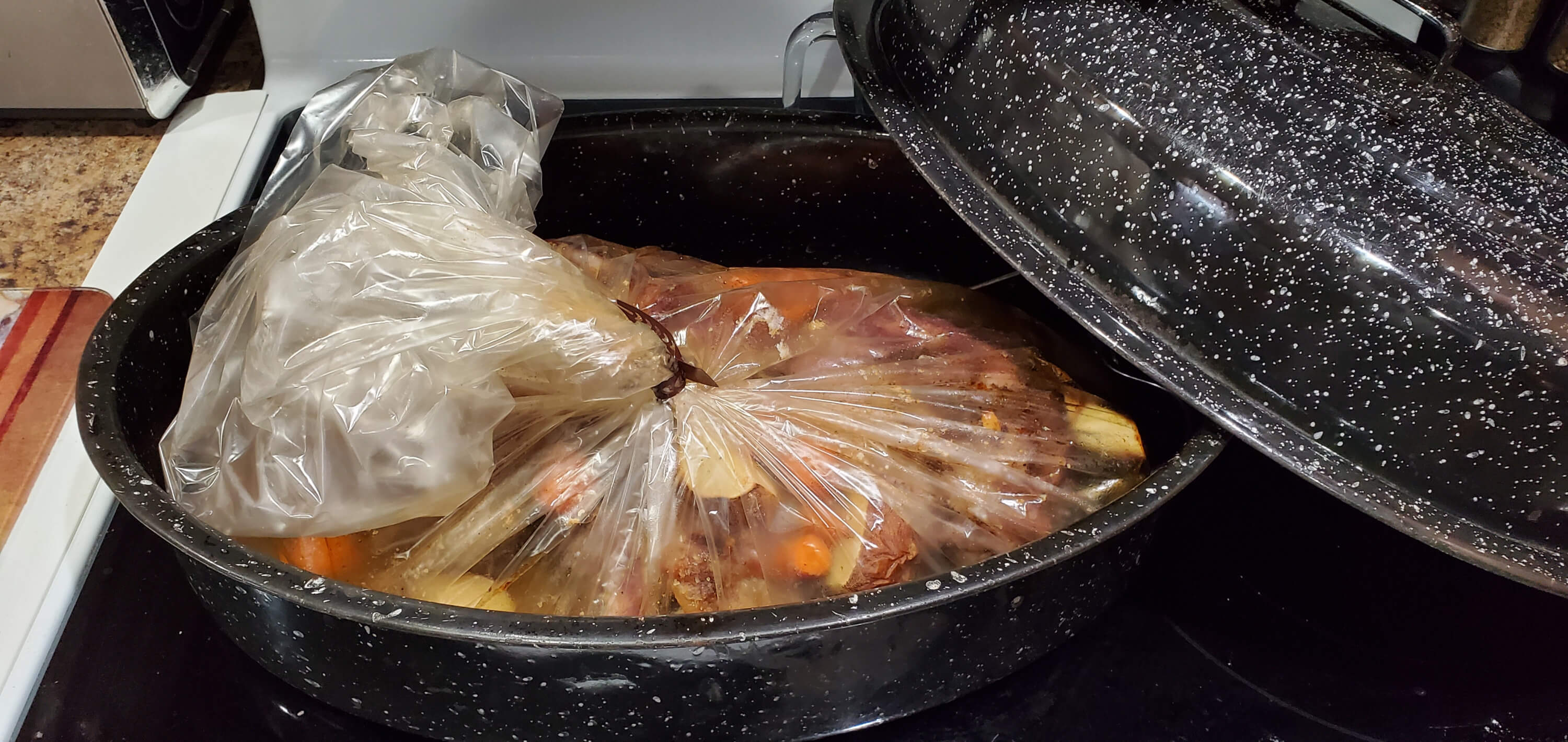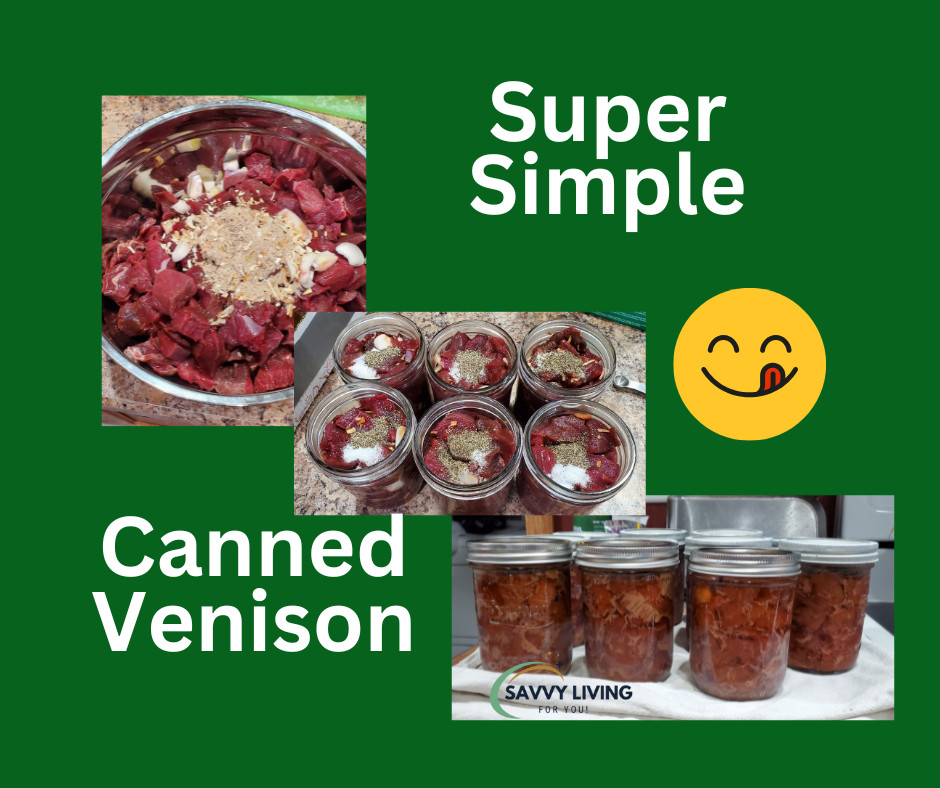
This Zucchini Spice Cake with Cream Cheese Frosting is a wonderful bridge between summer and fall. It’s one of those easy zucchini desserts that never goes out of style. It's warm spices are perfect for cozy gatherings, bake sales, or a simple treat with coffee.
Make it once, and it’ll become your go-to zucchini cake recipe every year!

The apple harvest was abundant this year! I have made SO MANY things with my apples and have found myself knee-deep in apple peels and cores after each busy day of pie-making or juice steeping. Those “scraps” are actually gold for your homestead kitchen. You can turn them into homemade apple scrap vinegar, a tangy, probiotic-rich pantry staple that works just like apple cider vinegar “with the mother.”
Once you’ve made your vinegar, you can feed the spent scraps to your chickens or toss them in the compost pile. Nothing wasted!
🧺 What You’ll Need
- 1 gallon bucket of apple peels and cores (from organic, pesticide-free apples — more cores = more flavor)
- 1 quart non-chlorinated water
- ¼ cup sugar
- A ceramic or glass bowl with a loose-fitting lid or clean dish towel cover
- A plate that fits nicely inside your bowl to keep scraps submerged
🍯 Step-by-Step: Making Apple Scrap Vinegar
1. Mix your sugar water.
Dissolve ¼ cup of sugar in 1 quart (4 cups) of non-chlorinated water. This sugar gives the natural yeasts something to feed on and kick-starts fermentation.
Dissolve ¼ cup of sugar in 1 quart (4 cups) of non-chlorinated water. This sugar gives the natural yeasts something to feed on and kick-starts fermentation.
2. Combine apples and liquid.
Place your apple scraps into your glass bowl or jar. Pour the sugar water over them until completely covered. If you need more liquid, just mix 1 tablespoon sugar per cup of water and add until everything’s submerged.
Place your apple scraps into your glass bowl or jar. Pour the sugar water over them until completely covered. If you need more liquid, just mix 1 tablespoon sugar per cup of water and add until everything’s submerged.
3. Keep it submerged.
Use a plate to weigh the apple pieces down under the water — this helps prevent mold. Any fruit exposed to air can mold and spoil your batch.
Use a plate to weigh the apple pieces down under the water — this helps prevent mold. Any fruit exposed to air can mold and spoil your batch.
4. Cover and ferment.
Loosely cover the bowl with a dish towel and loose lid that does NOT seal air-tight. This keeps out dust and fruit flies while still allowing air in. Let it sit at room temperature for 1–4 weeks, stirring every 12–24 hours (more often is better!).
Loosely cover the bowl with a dish towel and loose lid that does NOT seal air-tight. This keeps out dust and fruit flies while still allowing air in. Let it sit at room temperature for 1–4 weeks, stirring every 12–24 hours (more often is better!).
After about a week, you’ll notice bubbles — a sure sign that fermentation is happening. The smell will shift from lightly alcoholic to vinegary as the process continues.
If the apple bits start turning brown, you can strain them out anytime after the first week, but keep stirring the liquid daily and fermenting for at least 4 weeks total.
5. Strain and store.
After 4 weeks, strain out the remaining fruit using a fine filter or coffee filter. Transfer your finished vinegar to clean glass bottles or jars with screw-on or cork tops. Store it in a cool, dark place, and it’ll keep indefinitely.
After 4 weeks, strain out the remaining fruit using a fine filter or coffee filter. Transfer your finished vinegar to clean glass bottles or jars with screw-on or cork tops. Store it in a cool, dark place, and it’ll keep indefinitely.
🧠 Notes & Tips
- I’ve found a 4-quart Pyrex bowl perfect for making a half-gallon batch. A dinner plate fits just right to keep the peels submerged.
- Keep a dish towel over the top and a plug-in bug light nearby if fruit flies become an issue.
- Over time, you’ll see a cloudy film or jelly-like blob develop. That’s the mother (SCOBY) — the beneficial bacteria doing all the fermenting magic! You can leave it be or save a piece to jump-start your next batch.
- Stir often and keep the scraps submerged to avoid mold.
- Keep your vinegar away from other ferments (like sourdough starter or kombucha) to prevent cross-contamination.
🌿 How to Use Your Apple Scrap Vinegar
Use it anywhere you’d use apple cider vinegar:
- As a base for salad dressings or marinades
- Or add a splash to soups, stews, and sauces
- To use in pickling or canning recipes, you must test the pH, which needs to be at least 4.5% acetic acid.
Homemade apple scrap vinegar is one of those slow, simple projects that reminds us how little waste nature truly makes — and how much flavor comes from what we usually throw away.
If you enjoyed this practical recipe, you'll love using those apple scraps and any small or blemished apples to make your own apple juice too! Check it out HERE and them hop into our Home Instead facebook community for recipes, homestead tips, and fellowship. Check us out HERE!
Some links may be affiliate links. See full disclosure here.

🍎 The Apple Harvest Was Huge — And So Was My Savings!
This year’s apple harvest was overflowing — and with grocery prices climbing higher every week, my backyard apple tree turned into a true treasure. My kids love applesauce in their lunches, and this fall, I decided to skip the store-bought jars and make my own. The result? Over 20 pints of homemade applesauce that cost next to nothing and taste a hundred times better.
The best part? It was surprisingly easy — no fancy equipment, no complicated steps, and your whole kitchen smells like fall. Want to fill your pantry with cozy, sweet goodness too? Here’s exactly how I did it…
👉 Read the full post to learn my simple applesauce recipe, how to can it for the winter, and even how to use the scraps!
Read more...
Make restaurant-quality pasta at home with just 4 ingredients! Learn two simple methods to whip up fresh, flavorful noodles in minutes.
Read more...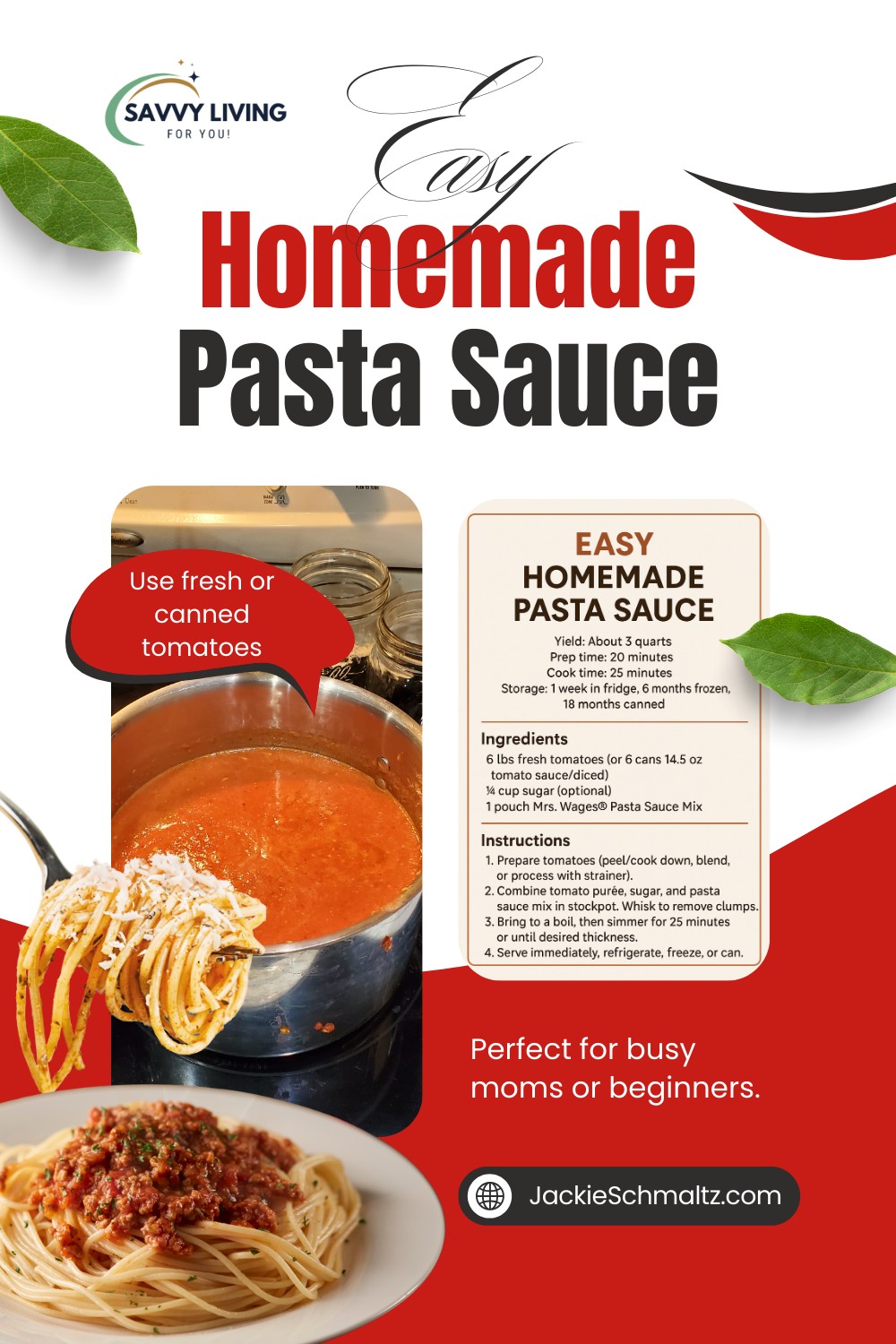
Homemade pasta sauce doesn’t have to be complicated, time-consuming, or expensive. With just a few simple ingredients, you can make a flavorful, wholesome sauce that beats store-bought every time.
Each summer, I end up with tons of volunteer tomatoes in my garden, and instead of feeling overwhelmed, I’ve learned to be grateful for the abundant blessings. One of the best ways I use them is by making my own pasta sauce—it’s healthy, budget-friendly, and so satisfying.
Why Make Your Own Pasta Sauce?
One of the biggest perks of homemade pasta sauce is that it’s naturally lower in sugar and unnecessary additives. Many store-bought sauces are loaded with sugar, oils, and preservatives.
By making your own, you can:
- Control the ingredients
- Cut back on added sugars
- Adjust thickness and flavor to your liking
- Enjoy a fresh, homemade taste
It even converted my “butter noodles only” kid into a “make it super saucy, Mom!” spaghetti lover. That alone makes it worth it!
What Tomatoes Work Best?
You can use:
- Fresh tomatoes – Roma varieties are great for thicker sauce, but juicy varieties or even cherries work too (just cook down longer).
- Canned tomatoes or sauce – Perfect in a pinch.
- Homemade canned tomato sauce – If you’ve preserved your summer harvest, this is the easiest option.
Tip: The juicier the tomato, the longer you’ll need to cook it down to thicken it up, or go with a thin sauce if you have no patience like me!
Step-by-Step: How to Make Pasta Sauce
Ingredients
- About 6 pounds of fresh tomatoes or 6 cans (14.5 oz each) tomato sauce or diced tomatoes
- ¼ cup sugar (optional but recommended)
- 1 pouch of Mrs. Wages® Pasta Sauce Mix
Equipment
- 5–6 quart non-reactive kettle like stainless steel; avoid aluminum.
- KitchenAid® attachment for processing tomatoes. Blender, food mill work too.
Directions
- Prepare the Tomatoes
- Option 1: Scald tomatoes in boiling water for 3 minutes, peel and core. (Messy and time consuming!)
- Option 2: Place whole tomatoes with seeds, peels, and stems in a blender. (We didn’t like the taste and texture.)
- Option 3 (my favorite): Use a KitchenAid® strainer attachment to easily separate seeds/skins from pulp. (Life-changing!) See how HERE.
- Cook the Sauce
- Combine tomato purée, sugar, and Mrs. Wages® Pasta Sauce Mix in your pot.
- Whisk well to remove clumps.
- Bring to a boil, then simmer for 25 minutes, stirring occasionally.
- Simmer longer for a thicker, richer sauce.
- Enjoy or Store
- Serve right away, refrigerate for up to 1 week, freeze for up to 6 months, or can for up to 18 months.
How to Can Pasta Sauce
- Make sure jars, sauce, and canner are all at the same temperature (hot sauce, in hot jars, with hot canner, cold with cold).
- Ladle sauce into clean mason jars, leaving ½-inch headspace.
- Wipe rims, add lids and bands finger-tight.
- Process in a hot water bath canner for 40 minutes.
- Let jars rest for 5 minutes, then carefully remove.
- Place on a towel, undisturbed, for 24 hours for proper sealing.
- Any jars that don’t seal should be refrigerated and used within a week, or frozen.
How to Use Pasta Sauce
I use 1 quart of sauce per 1 pound of browned hamburger and ~1 pound of pasta (uncooked weight) to feed my family of five. Sometimes there are leftovers, sometimes not!
Want to make it restaurant-level? Serve over fresh homemade noodles—no fancy Italian restaurant required.
That's it! Jump into my homesteading community on Facebook for more recipe, gardening, and homestead life sharing.
👉 Do you grow tomatoes too? What’s your favorite way to use them—sauces, salsa, or something else? Share in the comments!
Easy Homemade Pasta Sauce Recipe Card
Yield: About 3 quarts
Prep time: 20 minutes
Cook time: 25 minutes (plus more for thicker sauce)
Storage: 1 week in fridge, 6 months frozen, 18 months canned
Cook time: 25 minutes (plus more for thicker sauce)
Storage: 1 week in fridge, 6 months frozen, 18 months canned
Ingredients
- 6 lbs fresh tomatoes (or 6 cans 14.5 oz tomato sauce/diced)
- ¼ cup sugar (optional)
- 1 pouch Mrs. Wages® Pasta Sauce Mix
Instructions
- Prepare tomatoes (peel/cook down, blend, or process with strainer).
- Combine tomato purée, sugar, and pasta sauce mix in stockpot. Whisk to remove clumps.
- Bring to a boil, then simmer for 25 minutes or until desired thickness.
- Serve immediately, refrigerate, freeze, or can.
Some links may be affiliate links. See full disclosure here.
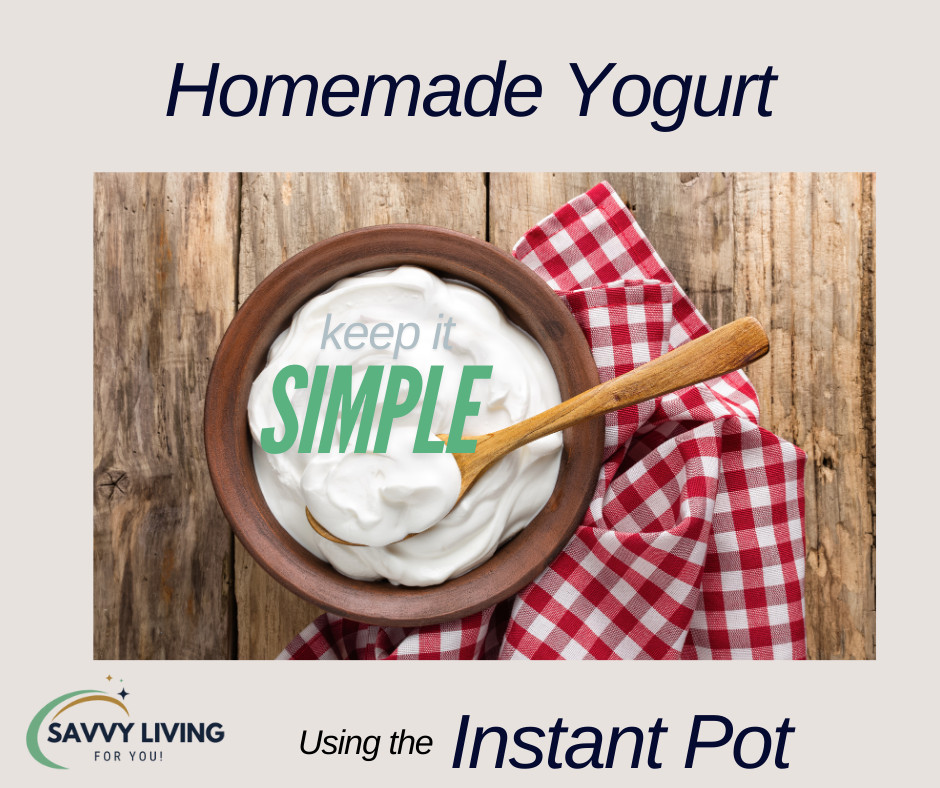
Had I known making yogurt at home was this easy, I would have started it years ago. Not-to-mention how extraordinarily delicious it is and economical. Think of your favorite high-end organic brand. That’s how this homemade yogurt turns out for me every time.
There are lots of different ways people will tell you to make yogurt. I find this way to be the easiest way to make yogurt at home, and it has always turned out great for me. (knock on wood) I’ve never had it fail yet. I make it almost every week, but It seems to keep a long time. The oldest jar I’ve found in the fridge was one month old and still fresh as ever. I have even frozen some short-term. Just thaw it slowly in the fridge.
Here’s what you’ll need For Plain Yogurt:
- Instant Pot with yogurt function
- Half gallon of milk (any kind will do)
- 2 Tbsp culture (see notes)
1. In the clean Instant Pot liner add the milk and press the yogurt button 3 times, until it reads "Boil". I usually cover with a glass lid. The IP lid with seal removed works if you don't have a glass cover that fits.
2. Once the pot beeps to signal the boil setting is done, the display will read YOGT. Remove the pot liner with the milk and place it in the fridge or ice bath or somewhere to cool.
3.Once it has cooled to be 100 degrees F or less, put the pot liner with milk back into the Instant Pot.
3. Whisk in the culture so there are no lumps. If you leave lumps, you will have lumpy yogurt.
2. Cover with a glass lid or the IP lid with seal removed.
3. Hit “yogurt” button until YOGT is displayed again, then make sure the “normal” setting is selected.
4. Set the timer for 20 hours. The timer will then be displayed. Your yogurt will be ready in as little as 8 hours and can be removed at any time thereafter.
5. Once the IP display reads YOGT your yogurt is done. You can either jar it up or put it in the fridge to set up a bit then jar it. If you wish it to be thicker you can hang it in a nut milk or jelly strainer bag tied to the handle of a pitcher to strain off the whey, or use a yogurt strainer. The longer it hangs, the thicker it will get. I find pint mason jars to be the best storage container for us.
Here’s what you’ll need For Vanilla Yogurt:
- Instant Pot with yogurt function
- Half gallon of milk
- 2 Tbsp culture (see notes)
- 1 can sweetened condensed milk
- 2 teaspoons vanilla extract
The process is the same. Add the other ingredients at the time you add the culture.
NOTES:
Culture: Any plain yogurt with live active cultures should work. I have great luck with Chobani Plain Greek yogurt or I use 2 Tablespoons of my own plain yogurt if I have some. Fresh is best, but I haven’t had a problem with using weeks old culture. I also don’t measure a perfect Tablespoon. I just scoop and dump.
The incubation time can be adjusted anywhere from 8-36 hours. The flavor and thickness will vary depending on the incubation time and the nature of your milk. Don’t be afraid to play around with this. If you find yourself a victim of poor planning like I often do, and your yogurt will finish in the middle of the night or while you’re away, etc, simply set the timer so it continues to incubate until you are ready to refrigerate it. However, if you happen to forget it, leaving the yogurt at room temperature for a limited amount of time will not make it go “bad” or deem it unsafe. Please do not throw it out if advised to by people who don’t understand the nature of home fermenting. In fact, we make a delicious version of cream cheese spread by actually hanging the yogurt at room temperature for a day, add salt and hang another day. Leaving it out will change the form or flavor. Taste test it to see what your next step should be. Maybe it wants to be sour cream instead?
Why remove the seal? I’ve only ever used a glass cover that fits my IP, but I’ve heard the seal from the IP lid can harbor odor from other foods that will leech into your yogurt, so if you don’t want last night’s chicken soup flavoring your yogurt, remove the seal if you’re using the IP cover.
Why “normal” setting? If you hit the yogurt button and you see the “less” setting is lit, hit the yogurt button one more time to get to the “normal” setting. This “less” setting did work for me when I didn’t know any different, but I was told that this is not the right temp for incubating yogurt and I was also using raw milk which has a different nature than pasteurized milk. I have since used the “normal” setting and it does indeed make better yogurt. The “less” setting is for proofing dough. The “normal” setting is for incubating yogurt. Please don’t throw your yogurt away if you made it on the “less” setting or left it out for a bit after the timer was finished. If it smells like yogurt, and it tastes like yogurt, you made yogurt. Enjoy it. See notes for incubation time.
Flavorings: Aside from the base of sweetened condensed milk and vanilla, add whatever other ingredients you want to make different flavors JUST BEFORE you are ready to eat it. Adding the extra fruits or honey will alter the bacterial environment and shorten the shelf life. We like to add fruit, jams and jellies when we’re in the mood for different flavors. This Daily Greens powder is a SUPER healthy mix-in we love too.
There you have it. The easiest way to make no-fail homemade yogurt that is the most delicious yogurt you will ever have.
Enjoy!
P.S. Easily turn your plain yogurt into sour cream and cream cheese. See how HERE.
And then hop into our Facebook community where other busy homestead families share our favorite things.
Some links may be affiliate links. See full disclosure here.
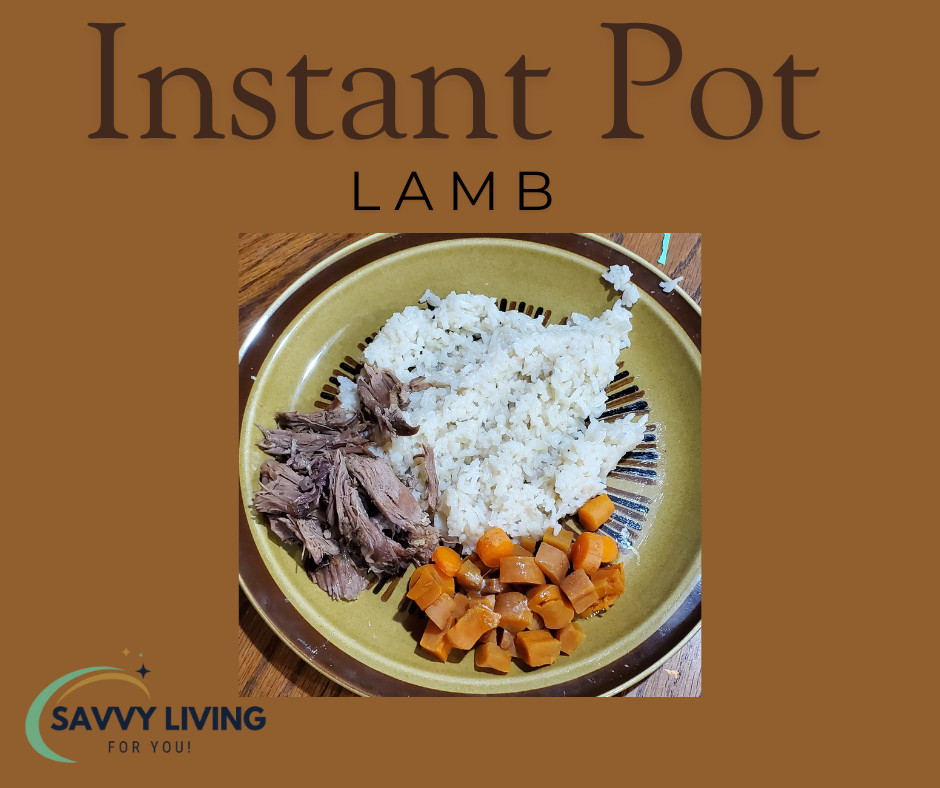
If you want fall-off-the-bone tender and juicy meat no matter the cut, that doesn’t take all day, the Instant Pot™ is your tool. I make most of my meat in the Instant Pot™ because it is hands-off and turns out tender and juicy every time. I can cook meat from frozen and still have supper ready in an hour, and I never have dry or tough meat. Here’s how:
- Prepare the meat. My go-to preparation for any cut of lamb is to cover it in garlic salt. Cut slits into the larger muscle sections and insert slabs of garlic cloves into the slits. This infuses flavor and seems to tenderize the meat.
- Load the pot. Place the wire trivet in the stainless-steel liner. Put the meat on the trivet. Lay slices of onion on top of the meat. Sprinkle with seasoning of choice over the meat. We like 1 Tablespoon of either Cajun seasoning or, our favorite, Baharat seasoning. Add enough water to cover the meat or fill up to the “max” line, careful not to pour water directly on the meat to wash off the salt and seasoning.
- Start cooking. Place the lid on the pot with the vent closed. Hit the desired button and let it cook. For most cuts of meat, “pressure cook” setting for 30 minutes will do. For larger cuts like roasts 40-45 minutes. If it's rock solid frozen, toss the 2-4 garlic cloves in the pot and cook for 90 minutes.
- Prepare to Eat! Once the meat is finished cooking, let the pressure release naturally until the safety pin drops and the lid can be opened. Pull the meat out using the handles on the trivet and set it on a baking sheet or large plate. Let it rest a few minutes, and then go to work slicing or shredding however you need. You'll find the bones will pull clean out and any fat left behind will easily separate from the meat so you’ll have tender, juicy, and lean meat to enjoy.
Note: This is the ideal way to cook cuts of meat such as the neck or loins and chops with spine still attached because the bones will fall out and separate easily and these smaller muscle pieces tend to dry out easily in the oven but stay juicy and tender in the Instant Pot™. For rump roasts, I prefer to roast in the oven for a little more flavor development.
Strain the leftover liquid through a milk filter or paper towel resting in a screen colander into mason jars. Let cool so all fat solidifies and can be scraped off. Then can or freeze this broth for a delicious broth to be used for gravy base, soups, or warm drink. The fat can be rendered further and used like tallow but do note that sheep fat has a different texture to it that might not be appealing to you. We prefer to feed it to the chickens.
You may be wondering about using the slow cooker setting. It will work. I find, however, that pressure cooking meat instead is fail-proof. I need fail-proof in my life. In fact, I just tried to make a neck bone from a recipe for lamb and rice in the crock pot from my father in-law the other day and ended up needing my Instant Pot to save the meal. After 6 hours of cooking, the meat came out tough. I didn't have 2-4 more hours to see if it would cook down more, so I figured I had nothing to lose by trying to re-cook it in the Instant Pot and see how it turned out. It came out falling apart, infused with flavor, and my family ate the whole thing. Nothing left but a plate of vertebrae and myelin sheath. That's how we like our lamb.
To see more recipes like this plus other ways we live a practical life on the homestead, check out our community on FB where we share practical homesteading tips for busy families.
Some links may be affiliate links. See full disclosure here.
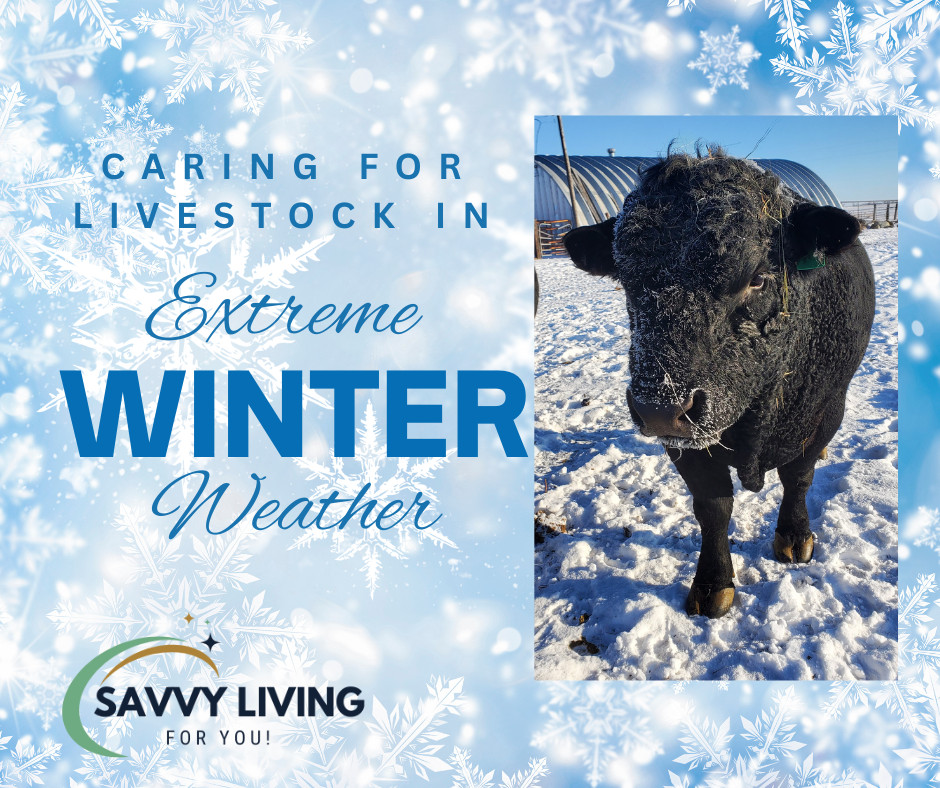
When temperatures plummet and the wind brings arctic chills, livestock care becomes a top priority. A polar vortex doesn’t just challenge us; it pushes our animals to their limits too. Keeping them healthy and comfortable during these extreme conditions is no small feat, but with the right preparations, you can make it through the cold snap together. Here are some tried-and-true methods to keep your livestock safe during a polar vortex.
1. Feed! Feed! Feed!
When it gets bitter cold, livestock burn more energy to stay warm. These extreme cold days are not the time to make the animals clean up their scraps. Instead, provide extra hay and high-energy grains. This is one of the simplest and most effective ways to help your animals maintain their body heat. When an animal eats, the fermentation within the stomach naturally generates heat. This "internal furnace" helps your animals combat bitter winds and freezing temperatures.
Keep an eye on feeding areas to ensure there's always enough hay available, especially during peak cold hours like early mornings and late evenings. If you have pastured livestock, supplement with hay even if they usually forage for themselves—frozen pastures cannot provide the same energy to sustain them during a cold spell. We also supplement our livestock with corn or oats when temps hit well below zero.
2. Water and Minerals
Water might seem like common sense in the summer, but hydration is crucial, even in freezing weather. Dehydrated animals are more susceptible to stress, illness, and cold-related conditions. Just as the dry air of winter leaches moisture from your own skin, it sucks the hydration from your animals too. That, and the fact that they are eating more dry roughage hay and consuming more salt (keep reading) will cause them to be extra thirsty. Make sure your water tanks are easily accessible. Investing in heated waterers or adding tank heaters can save you from constant de-icing and ensure your animals are getting enough to drink.
Alongside fresh water, minerals and salt play a vital role in maintaining your livestock’s overall health. I noticed our sheep and cattle especially have really hit the mineral feeders hard these past few days of -20⁰F and below. Vitamin and mineral intake helps regulate body temperature. Think of how salt melts ice by dropping the freezing point of water. Works similar in the body. Plus, water follows salt, so if you want all that water your livestock are drinking to be absorbed and hydrate the animal, they need salt. Providing free-choice minerals or salt so your animals can replenish what their bodies need is just as important during extreme cold as it is in the summer heat.
3. Provide Deep, Dry Bedding for Warmth
Animals lay on their legs to keep them warm. Deep bedding helps insulate their bodies from the frozen ground and keeps them off the icy, wet surfaces that can sap body heat quickly. Straw and wood shavings are excellent options for bedding, as they retain warmth and allow animals to burrow down for extra coziness.
Check bedding daily for moisture, as damp bedding can do more harm than good—it not only chills the animals but also increases the risk of frostbite and infections. Add fresh bedding frequently to ensure your livestock have a dry and warm place to rest. For larger animals like cattle, consider windbreaks or shelters as additional barriers from the blistering cold.
4. Wind and Shelter Protection
Speaking of shelter, providing your animals with a sturdy, windproof enclosure is critical. Whether it’s a barn, lean-to, or windbreak structure, having a place for them to escape the direct brunt of the wind can prevent frostbite and stress. Be mindful of ventilation as well; too little airflow can lead to moisture buildup, while too much exposure invites drafts.
5. Monitor Animals Closely
During extreme weather, keeping a close eye on your animals is essential. Look for warning signs of cold stress, such as shivering, lethargy, or huddling tightly together. Additionally, monitor their feed and water intake to ensure they’re maintaining their normal routines. Sick or weaker animals will require extra attention and potentially additional shelter and feed to help them recover.
6. Stay Prepared and Plan Ahead
Polar vortex conditions can escalate quickly, so planning ahead will save you from scrambling when the storm hits. Stock up on hay, bedding, and mineral supplies early. Check your watering equipment to ensure it’s functioning properly, and have a back-up plan in case of power outages or freeze ups. A little preparation can go a long way in protecting your animals during these harsh conditions.
Caring for livestock during a polar vortex is no easy task, but your extra efforts will make all the difference in your animals' health and well-being. By feeding extra hay, ensuring access to water and minerals, and providing deep, dry bedding, you can help your animals thrive even in the coldest weather. Remember, your livestock are counting on you, and with the right care, you'll both make it through to warmer days ahead.
Stay warm and stay safe during this polar vortex, and give your animals an extra treat for braving the cold!
See what else people are up to on their homesteads in our community for practical homesteading for busy families HERE.
and how I keep myself warm when I'm doing chores during these cold spells HERE.
Some links may be affiliate links. See full disclosure here.

North Dakota winters can get pretty brutal cold here, but hey, we don’t have hurricanes or poisonous things, right?
Anyway, as someone who has zero body insulation, I’m always cold. I’m always the first to bundle up when temps start getting cool in fall and the last to let my gator and gloves go for the summer. Yes summer. I wear gators and gloves into summer because I’m always cold.
Because of my extreme dislike for being cold, but also an even more extreme dislike for hurricanes and poisonous things, I’ve found some pretty great gear to keep me warm because as a livestock producer, we just don’t get days off for inclement weather. In fact, we usually end up pulling double duty outside when the polar vortex hits because things break, equipment won't start, waters freeze, and animals need extra care and feed to keep warm. So how do I do it? Here are my best finds from the feet up.
Feet:
Inner layer. Some good smart wool socks. Feet and fingers are the first to get cold, so keeping the feet warm is key. Keeping them dry is the secret to keeping them warm and that is why a good wool sock is what you want. Wool wicks away the natural moisture your feet will give off as they breath and sweat so your feet stay warm. I found most wool socks to be thick and sloppy. If they’re too thick, they make your boots fit snug which also causes your feet to get cold. Your feet need wiggle room to keep circulation flowing. I also hate it when socks fall down in my boots, or come completely off. The SmartWool brand of socks remedy both these issues. They fit nice on the foot, stay in place and they aren’t super thick and bulky, they fit more like a regular sock, and they are comfortably soft, not itchy.
Outer Layer: I have two pairs of boots. My warm hunting boots and my snow-is-deep warm Muck boots. Both are good warm boots. Warmer than any winter boot I’ve owned. The hunting boot is lighter and more comfortable to wear and walk around in, but the lugs track in mud, snow and manure. When the snow gets deep or it is muddy or wet out, I opt for the Muck boots. If these were lighter, they would be all I own and in putting them to a comparison test this last polar vortex, the Muck boots proved to be warmer than my hunting boots.
Legs:
Inner layer: A good pair of long johns makes a huge difference. I’ve found these under armor base layers to be the most comfortable and warmest. Many long johns will slide down and sag in the crotch which is annoying and restricts movement. These stay in place. They fit snug, so they don’t creep up when you put your pants on over them. I hate having to reach up the leg to find your long johns up by your knees. These don’t do that, or pile up at the waist either. They are skin tight with a soft fleece inside so they’re not itchy. They check all my boxes for a fit, function, and fashion.
Middle layer: Jeans are the warmest, but not the most comfortable to wear so I’m all for a good thick pair of sweatpants. Thin won’t do though, so make sure they are nice and heavy, I like these fleeced-lined track pants or these sherpa lined ones are nice too, but go for denim jeans if you need more warmth.
Outer layer: Insulated Carhart bibs. I have ski bibs that are like my kids’ snow pants for “city outings” and they are noticeably NOT near as warm as my Carhart bibs I wear for chores. So go with Carhart bibs. They are more durable for working in too. I can move more freely in the bibs than a total one-piece coverall suit. I don’t like feeling restricted in movement. Can you tell?
CORE:
Inner layer: same Under Armor base layer as the legs. This under a normal sweatshirt is usually enough, but during this last polar vortex cold spell where we hit -50⁰F windchill I opted for my shirpa-lined sweatshirt to go over the base layer. It adds a bit more bulk, but is noticeably warmer. It’s like wearing a cozy blanket and I love it.
Middle layer: I am in love with this heated vest. It is my new winter gear staple. It prevents me from getting chilled better than anything else I have ever tried. I have a heated jacket I love too, but I like this vest even more because it fits closer to the body so you can actually feel the heating elements. I have yet to get chilled at my core while wearing this glorious invention.
Then to keep that heat in and the gusting ND winds out I love this insulated liner. You can wear all the layers you want, but if you don’t have some sort of a wind-breaking layer, you’ll feel drafts and get cold. It’s science. This liner is something I wear for all seasons. It’s comfortable, functional, and easy to keep clean.
Outer Layer: Insulated Carhart jacket. Yes, Carhart is king in chore gear / workwear. They are just so warm and durable to work in. a little heavy, but well worth the investment. They last.
Gloves: I have not found gloves that I love yet, so if you have, please share them. I’m tempted to try the heated gloves I’ve seen out there, but I feel like they wouldn’t hold up doing chores in them and they are a bit of an investment to be replacing often. So for now, I just buy insulated ski gloves. I go through a few pair each winter because they snag on things and get holes in them and it’s hard finding a pair that doesn’t sweat inside. I hate soggy gloves. The pair I have came from Walmart, but I linked them from amazon for your convenience to know a good pair that doesn't sweat, and so far, it's the end of January and I have only worn through across the index fingers because I snagged them on the fence.
Head: A neck gator is a must. I have a thin cloth gator I wear in the early fall or spring when people might look at me like I’m weird for wearing the heavy fleece one I wear all winter, but I love feeling cozy, I hate getting wind drafts down my shirt. A gator solves these issues for me. Plus, I can pull it up to my eyeballs when it’s freeze-your-face cold out. You're looking for double layered. Single layers are too thin and any breeze will go right through.
Good warm hats are hard to find, but they are out there. I wear a fleece earband first, then put a thick hat that has a fleece liner that goes all the way to the top so it is double layers. When it’s really cold or windy the bomber hat comes out. Wrap those rabbit fur flaps around your cheeks paired with the fleece gator and you’re good to go. Be sure it has a wind proof material on the head though, or your head will get cold in the wind.
So there you have it. How I dress head to toe when the wind blows and temps get frigid cold in North Dakota. As someone who is always cold and hates being cold, staying warm is super important to me, and I’ve gotten quite good at it.
Now that you've prepared yourself for the arctic tundra, CLICK HERE to read how to get your animals through these harsh cold snaps.
Be warm!
Some links may be affiliate links. See full disclosure here.
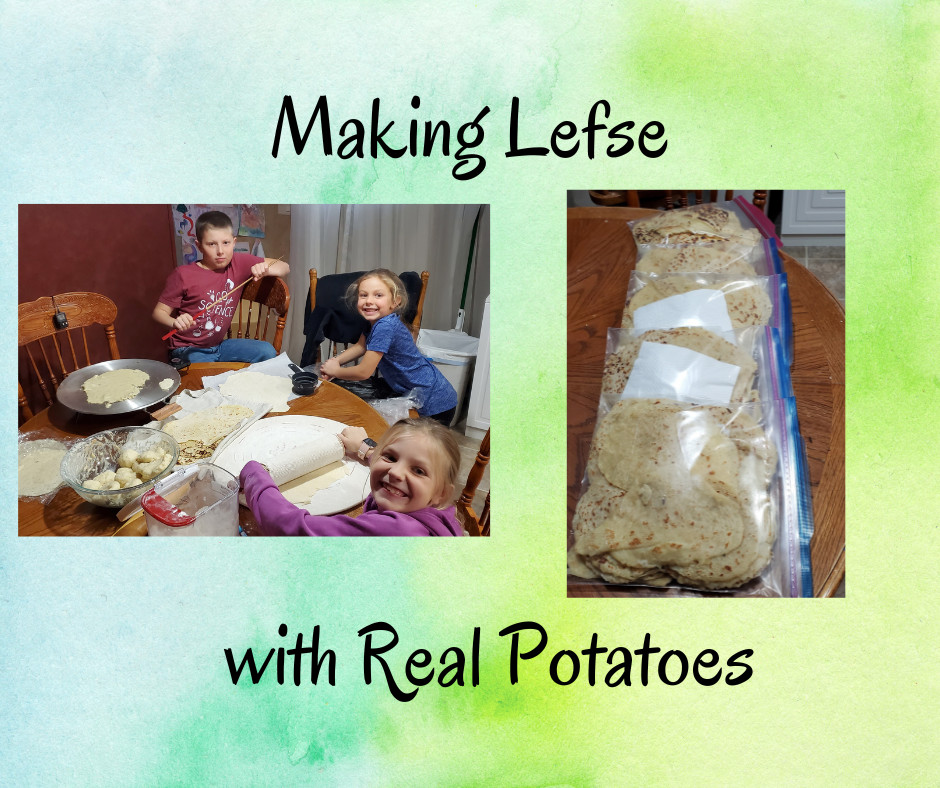
This traditional lefse recipe has been passed down in our rural ND community for generations. It is easy to make and tastes delicious. It freezes well which makes it a great option for preserving that abundant garden potato harvest or bulk grocery store find.
What you’ll need:
- 6-quart stock pot for boiling potatoes
- Lefse making kit (see note 1 for equipment details)
- Food mill with Potato Ricer disc
- ~5 pounds of potatoes to make 8 cups mashed. (see note 2)
- ½ cup melted butter
- ½ cup heavy whipping cream
- 2 Tablespoons sugar
- 1 Tablespoon salt
- 4 cups Flour + more for flouring surface if needed (see note 1).
Make It:
- Boil and peel the potatoes. (see note 2)
- Run the cooked, peeled potatoes through the potato ricer. Measuring out 8 cups.
- To the 8 cups riced potatoes add the ½ cup melted butter, ½ cup cream, 2 Tbsp sugar, 1 Tbsp salt. Mix until incorporated. If it’s still hot, let cool to just warm.
- Add the 4 cups flour, one or 2 cups at a time. Knead with your hands until all the flour is absorbed and a nice sticky dough is formed.
- Roll the dough into balls (see note 3.) Let rest while you prepare your rolling/cooking area. Plug in the griddle, set to 500⁰F.
- Roll out the dough balls until they are as thin as possible while still being manageable; about ¼”. Too thick, they won’t cook through, too thin, they’ll tear and be hard to handle. (See Note 1 for my best tricks)
- Carefully maneuver rolled out lefse onto the UN-greased griddle and cook for 1:30 minutes. Flip. Cook another 1:30 minutes. Remove to a cooling wrack….or eat it right then.
Notes:
- They sell Lefse making kits which are a great investment with everything you need to start out, but over the years I have found rolling the dough on a floured surface with a covered rolling pin to be time consuming and uses a LOT of flour…and it's messy. I invested in a tortilla press and will never go back. It takes just seconds, not minutes, to roll out perfectly round lefse and eliminates the need for the rolling pin and flouring board that comes in the kit. You'll still want a flipping stick and will need the griddle or two.
To roll out lefse using a tortilla press simply sandwich the dough ball in between cling wrap and put the press down until it’s the desired 1/4" or less thickness. Peel one side of the cling wrap off, then flip the lefse in your hand to peel the other side off and plop it on the griddle. No flour needed, which makes for no mess and no chalky lefse. No more frustrations of lefse sticking to the flour board or rolling pin. It was a game changer for making multiple batches.
2. Russets are traditional, but I’ve found that all potatoes will work, even purple potatoes. If you boil the potatoes first, the peels will strip right off if you keep them wet.
3. Roll the dough into balls that are slightly bigger than a golf ball to no bigger than a baseball, finding the right size for you. My littles are still young, so I’ve found the smaller 8” lefse to be easier to press, handle and eat.
To Eat:
Lefse is versatile. It can be eaten for breakfast, dessert, or part of a meal. Use it like any flatbread or tortilla or as it is. Our favorite way to eat lefse is warm with butter, sprinkled with cinnamon and sugar. I also like eating it like a crepe with fruit and yogurt rolled up in it. Or make a savory wrap for lunch. Sky is the limit! I’d love to know how you like your lefse.
That’s it! Easy and delicious traditional lefse made with real garden potatoes and maybe even cream and butter from your own dairy animal or your own home-milled flour. So good!
Happy Homesteading!
For more homesteading recipes like this, hop in our Facebook community HERE and GET ON THE LIST to grab my upcoming book, Abundant Homestead; practical ways to use your homestead harvests and enjoy the fruits of your labor.
Some links may be affiliate links. See full disclosure here.
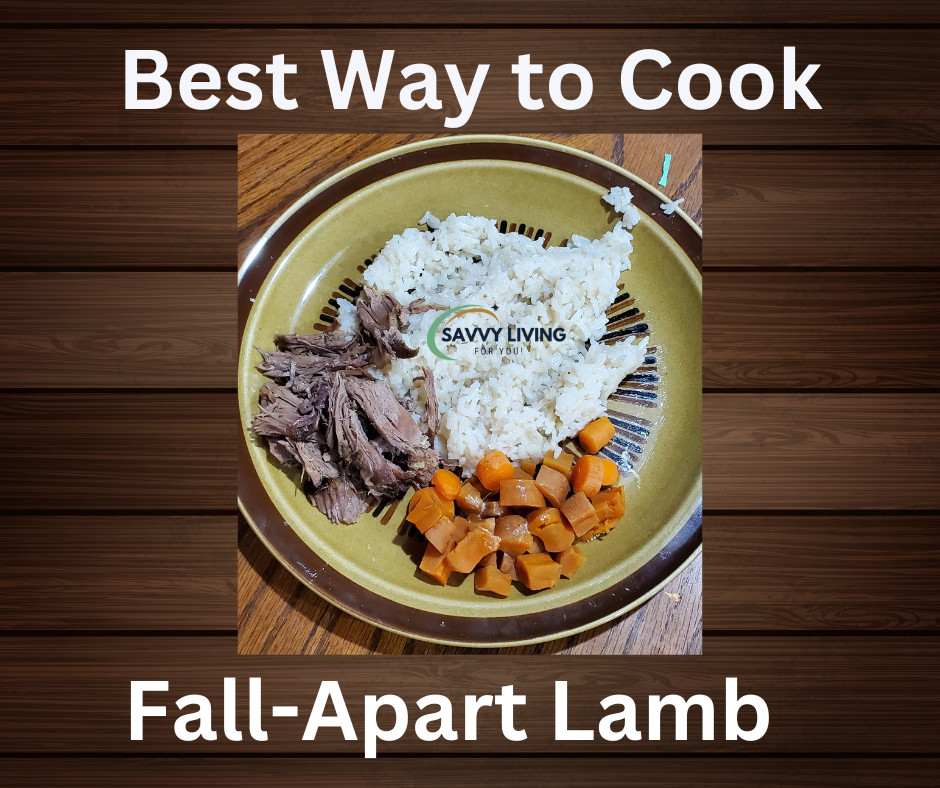
This easy roasted lamb recipe will be the most delicious mutton you will ever have. It's tender, moist, and delicious flavor will have you feeling like a top chef. But, the ease of making this will fit into any busy homesteading mom's day.
I’ll never forget the moans of delight that came from my son after every bite he took of this roasted lamb meal the first time I made it. This recipe comes from a friend of mine from the Middle East where they eat mutton like we Americans eat beef. So when I wanted to master the mutton, my Middle Eastern friend was definitely the person to ask. This lamb recipe took our mutton experience from so-so, to a top 5 favorite, and this is how it's done....
What You’ll Need:
Lamb rump roast or loins
Garlic
Onion
Kosher salt
Kosher salt
Black pepper
Water
Apple cider vinegar
Vegetables of choice
Make it:
- Prepare the oven bag as directed on package instructions. Place the bag on a trivet/wire rack inside the roasting pan.
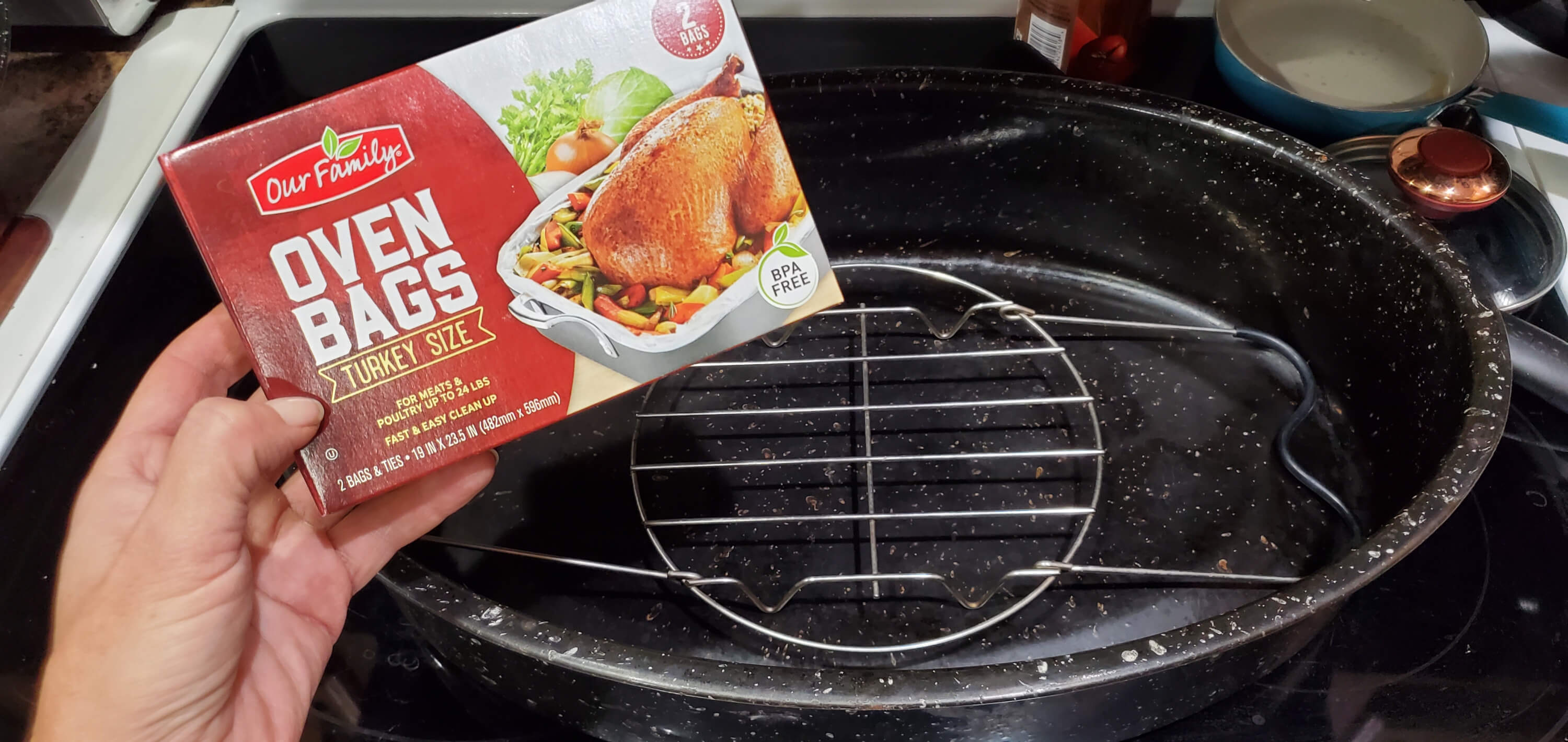
- Cut tiny slits in the meat every few inches and stick slices of garlic cloves in them.
- Mix together a rub of 1 Tablespoon Kosher salt, 1 teaspoon Baharat spice, ½ teaspoon black pepper. Rub all over the meat.
- Place the seasoned meat inside the oven bag and add 1 cup water, 1 chunked onion, ½ cup apple cider vinegar^, any vegetables you wish to roast.
- Close up the bag and tie according to package instructions, making the steam vents as directed for the oven bag. I like to keep the bag snug around the meat so the meat sits in the juices.
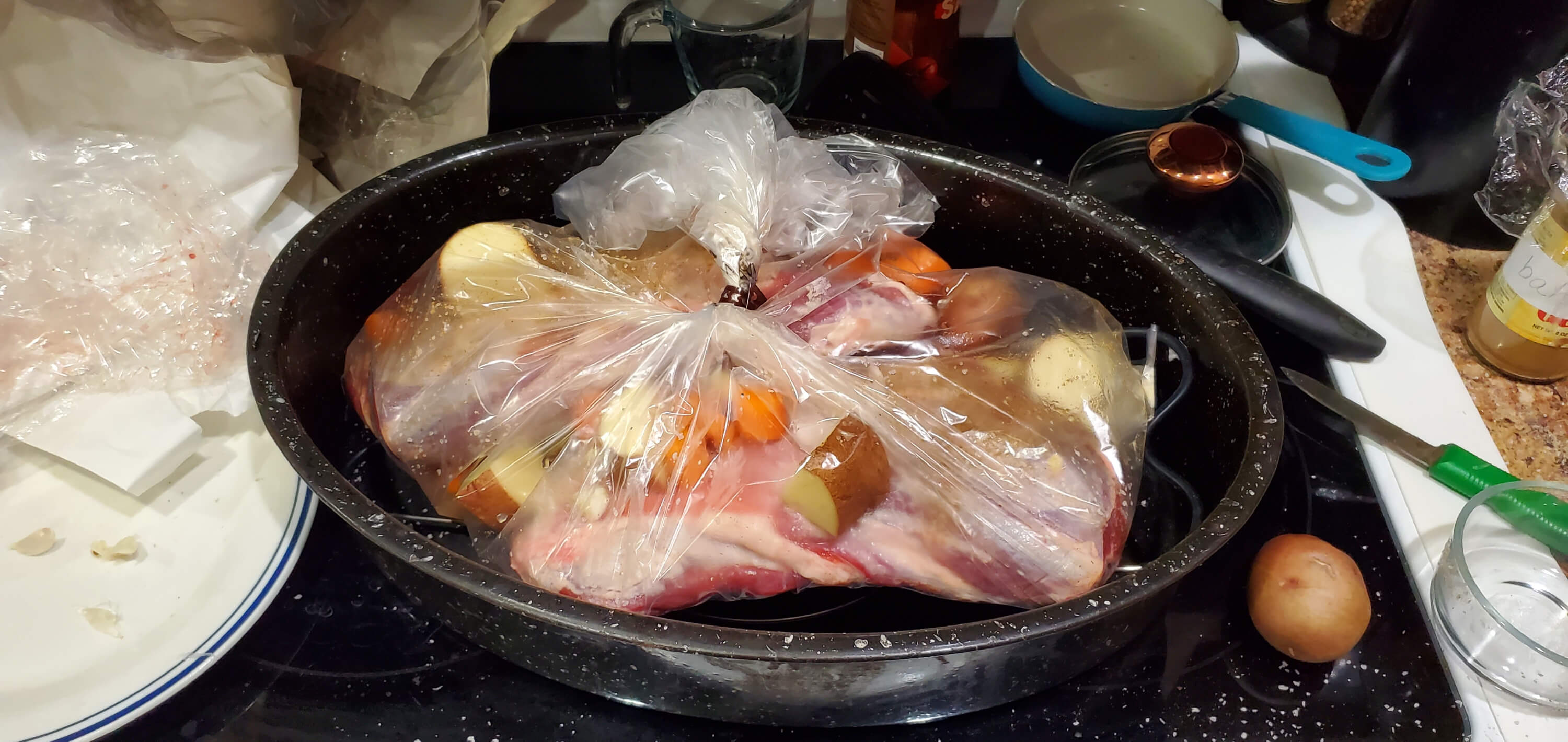
- With the bag of seasoned meat and veggies placed on the trivet inside the roasting pan, cover and cook at 320⁰F for 4 hours or until meat falls apart with a fork.
- When the meat is cooked, poke a hole in the bottom of the bag to drain the juices into a measuring cup. Place in fridge to allow fat to solidify for easy removal. This liquid can be used to make a gravy or au jus sauce, whichever you prefer.
- Serve the lamb with vegetables over rice, topped with the gravy or au jus.
^ apple cider vinegar is optional, but it adds a noticeable depth to the flavor. Homemade apple scrap vinegar also works great and is preferred by us.
Special note: you're probably wondering if the Baharat spice is worth buying because, unless you're from the Middle East, you won't already have it in your spice cabinet. My answer to this is YES! Get it! It quickly became a pantry staple that I use on everything, especially meats and soups. It has a hint of cumin, but that is the only particular spice I can make out. It is a unique blend of warm, comforting, savory spices. It will not disappoint. PROMISE.
To Make Gravy:
In a stainless-steel pot make a roux by melting 2 tablespoons butter. Add 2 Tablespoons flour. Mix well into a paste and let cook a minute or two. You’ll then add 2 cups liquid*. Whisk until there are no lumps. Keep whisking until the gravy thickens to your liking. Remove from heat. The gravy should set a little more as it cools.
*You’ll need to taste the broth from the roast for saltiness and adjust the broth to water ratio to get the right flavor balance you’re looking for in 2 cups of water/broth liquid.
Enjoy the meat and vegetables served over white rice with gravy or au jus.
There you have it! A super simple, extremely tender, moist, and delicious lamb recipe the whole family will enjoy.
For more ways to enjoy the fruits of your homestead, jump in our community of busy homesteading families where we share practical tips for homesteading success. We'd love to have you.
Some links may be affiliate links. See full disclosure here.
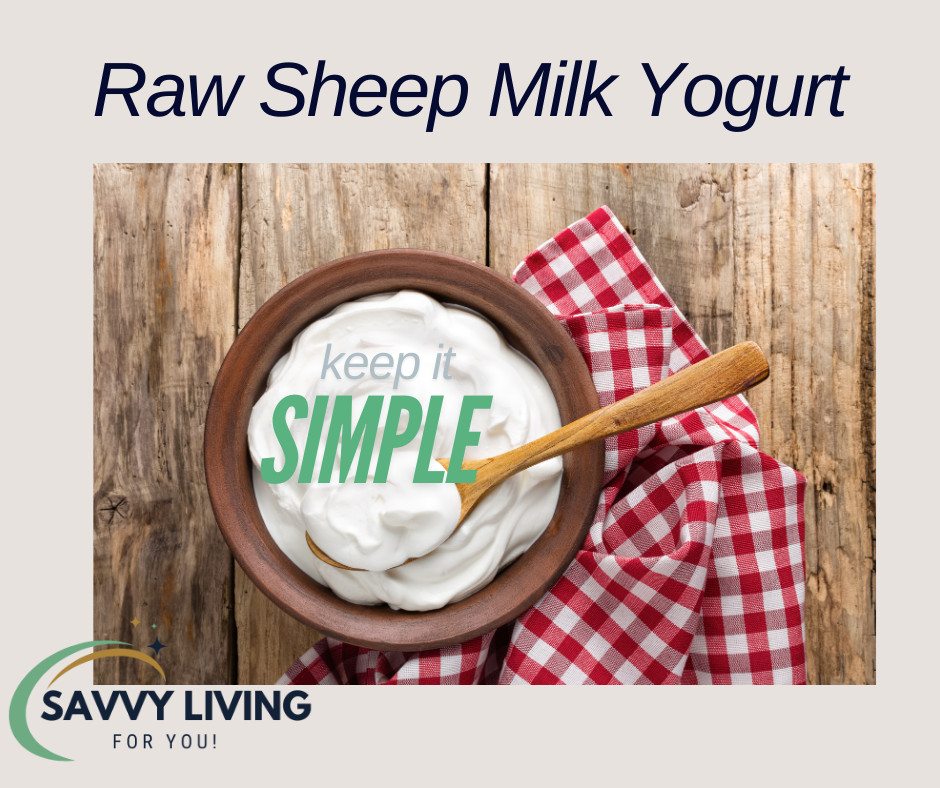
Had I known making yogurt at home was this easy, I would have started it years ago. Not-to-mention how extraordinarily delicious it is and economical. Think of your favorite high-end organic brand. That’s how this homemade yogurt turns out for me every time.
There are lots of different ways people will tell you to make yogurt. I find this way to be the easiest way to make yogurt at home, and it has always turned out great for me. (knock on wood) I’ve never had it fail yet. I make it almost every week when my sheep are in milk. It seems to keep a long time. The oldest jar I’ve found in the fridge was one month old and still fresh as ever. I have even frozen some short-term. Just thaw it slowly in the fridge.
Here’s what you’ll need For Plain Yogurt:
- Instant Pot with yogurt function
- Half gallon of milk
- 2 Tbsp culture (see notes)
1. In the clean Instant Pot liner add some of the milk and whisk in the culture so there are no lumps, then add the remaining milk. Whisking well again. If you leave lumps, you will have lumpy yogurt.
2. Cover with a glass lid or the IP lid with seal removed.
3. Hit “yogurt” button, then make sure the “normal” setting is selected.
4. Set the timer for 20 hours.
5. Once the IP display reads YOGT your yogurt is done. You can either jar it up or put it in the fridge to set up a bit then jar it. If you wish it to be thicker you can hang it in a nut milk or jelly strainer bag tied to the handle of a pitcher to strain off the whey. The longer it hangs, the thicker it will get. I find pint mason jars to be the best storage container for us.
Here’s what you’ll need For Vanilla Yogurt:
- Instant Pot with yogurt function
- Half gallon of milk
- 2 Tbsp culture (see notes)
- 1 can sweetened condensed milk
- 2 teaspoons vanilla extract
- In the clean Instant Pot liner add some of the milk and whisk in the culture so there are no lumps, then add the sweetened condensed milk and vanilla, whisking until smooth. Then add the remaining milk. Whisking well again. If you leave lumps, you will have lumpy yogurt.
- Cover with a glass lid or the IP lid with seal removed.
- Hit “yogurt” button, then make sure the “normal” setting is selected.
- Set the timer for 20 hours.
- Once the timer is done and your IP display reads YOGT your yogurt is done. You can either jar it up or put it in the fridge to set up a bit then jar it when you have time. If you wish it to be thicker you can hang it in a sterilized dish towel to strain off the whey. The longer it hangs, the thicker it will get. I find pint mason jars to be the best storage container for us. See how I make sour cream to see my set-up for hanging.
NOTES:
Heating Milk: I do not heat the milk and let it cool as most people will for a few reasons; 1. It destroys the benefits of using raw milk, 2. It’s an extra step that isn’t necessary. My yogurt turns out perfectly every time without heating and cooling the milk, 3. I don’t have time to sit and babysit slowly heating milk to temp and then wait for it to cool down to just the right temperature again. I’ve got other things to do.
Culture: Any plain yogurt with live active cultures should work. I have great luck with Chobani Plain Greek yogurt or I use 2 Tablespoons of my own plain yogurt if I have some. Fresh is best, but I haven’t had a problem with using weeks old culture. I also don’t measure a perfect Tablespoon. I just scoop and dump.
The incubation time can be adjusted anywhere from 8-36 hours. The flavor and thickness will vary depending on the incubation time and the nature of your milk. Don’t be afraid to play around with this. If you find yourself a victim of poor planning like I often do, and your yogurt will finish in the middle of the night or while you’re away, etc, simply set the timer so it continues to incubate until you are ready to refrigerate it. However, if you happen to forget it, leaving the raw milk yogurt at room temperature for any amount of time will not make it go “bad” or deem it unsafe. Please do not throw it out if advised to by people who don’t understand the nature of raw milk and home fermenting. In fact, we make a delicious version of cream cheese spread by actually hanging the yogurt at room temperature for a day, add salt and hang another day. Raw milk doesn’t “go bad”. It just changes form or flavor. Taste test it to see what your next step should be. Maybe it wants to be sour cream instead?
Why remove the seal? I’ve only ever used a glass cover that fits my IP, but I’ve heard the seal from the IP lid can harbor odor from other foods that will leech into your yogurt, so if you don’t want last night’s chicken soup flavored yogurt, remove the seal if you’re using the IP cover.
Why “normal” setting? If you hit the yogurt button and you see the “less” setting is lit, hit the yogurt button one more time to get to the “normal” setting. This “less” setting did work for me when I didn’t know any different, but I was told that this is not the right temp for incubating yogurt. I have since used the “normal” setting and it does indeed make better yogurt. The “less” setting is for proofing dough. The “normal” setting is for incubating yogurt. Please don’t throw your yogurt away if you made it on the “less” setting. If it smells like yogurt, and it tastes like yogurt, you made yogurt. Enjoy it. See notes for incubation time.
Flavorings: Aside from the base of sweetened condensed milk and vanilla, add whatever other ingredients you want to make different flavors JUST BEFORE you are ready to eat it. Adding the extra fruits or honey will alter the bacterial environment and shorten the shelf life. We like to add fruit, jams and jellies when we’re in the mood for different flavors. This Daily Greens powder is a SUPER healthy mix-in we love too.
There you have it. The easiest way to make no-fail raw milk yogurt that is the most delicious yogurt you will ever have.
Enjoy!
P.S. Easily turn your plain yogurt into sour cream and cream cheese. See how HERE.
And then hop into our Facebook community where other busy homestead families share our favorite things.
Some links may be affiliate links. See full disclosure here.
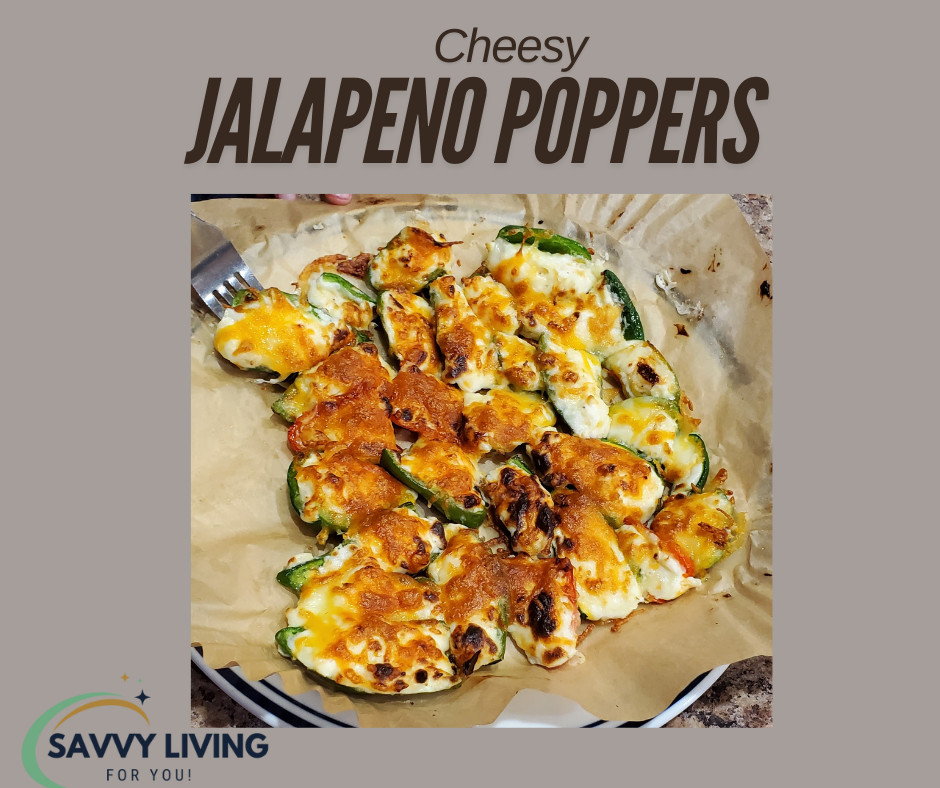
Jalapeño Poppers
It’s that time of year when I dig up my pepper plants from the garden and bring them inside for the winter. I love doing this because for one, it saves me from having to buy new plants or seeds in spring, and two, many times I get peppers from them in the winter. I only wish I had a giant greenhouse room to have more plants inside.
So what do I do with all those peppers? Most years I will pickle a few jars, but this Jalapeno Popper recipe is another delicious way we use up our peppers. Using Jalapeno for a little kick and bell peppers for the girls who don’t like spicy. You can make these in the Air Fryer or in the Oven.
What you’ll need
- ~12 Jalapeño peppers cut in half, seeds removed (wear gloves when you do this)
- 8 oz cream cheese at room temperature
- 1 cup shredded cheese, cheddar or a blend is what we like
- ½ tsp garlic powder
- ¼ tsp sea salt
- ¼ tsp black pepper (optional)
- 4 slices precooked bacon (optional)
Instructions
- Prep the jalapenos. While wearing rubber gloves, slice the peppers in half, remove the seeds and membranes. The spice is in the membrane, so if you like more spice, leave the membrane in. You can leave the tops on or off. We like them off for faster deposits into the mouth.
- Mix the filling. Mix together the cream cheese, shredded cheese, garlic powder, salt and pepper. I like to use my KitchenAid stand mixer with the beater paddle for this.
- Prep your pan. If using the Air Fryer, line it with these parchment liners for easy cleanup. If using the oven, line a sheet pan with foil or parchment. Nobody has time to be scrubbing baked cheese off pans.
- Fill the Peppers. Fill the pepper halves with the cream cheese filling and top with additional shredded cheese and bacon. Side note: Any filling left over goes really well on top of baked potatoes.
- Bake. If using the Air Fryer, bake at 400⁰F for ~5 minutes until cheese is golden how you like it. For the oven, bake at 400 for 10-15 minutes.
That’s it! Enjoy these delicious Jalapeno poppers as party hors d’oeuvre, appetizers, or a healthy snack.
For more recipes and ideas for what to do with your abundant homestead and garden harvests, join our Facebook community and stay tuned for the release of my new book, Abundant Homestead, a collection of practical ways for busy families to use and preserve your homestead harvests. Get on the list to get a free copy HERE.
Some links may be affiliate links. See full disclosure here.
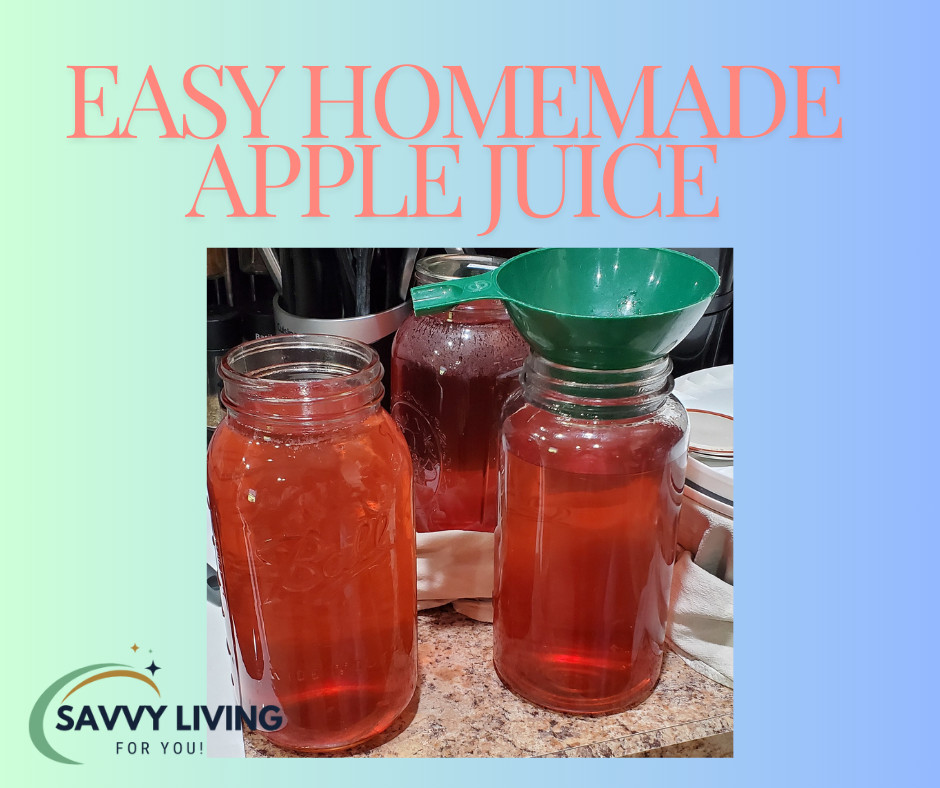
The easiest way to use up excess apples is to turn them into homemade apple juice using this hands-off method that your whole family will love.
Read more...This is one of my favorite farm-to-table recipes. Life as a busy homesteading family can often make it feel impossible to eat healthy, balanced meals. Between work, school pick-ups, and sports, the simplest things—like making a nutritious dinner—can seem overwhelming. But what if I told you that a delicious, healthy meal can be prepared in no time? And the kids will love it too? And almost all of the ingredients come right from the homestead?
Enter chicken zucchini bites! This recipe is perfect for those on a paleo or gluten-free diet, or anyone looking for a fast but wholesome meal option. Not only are these little delights packed with flavor, but they also bring the farm-to-table goodness right to your kitchen.
Why You'll Love These Chicken Zucchini Bites
- Healthy and Nutritious: Made from whole food ingredients, these bites are a great source of lean protein and vegetables.
- Quick and Easy: With a prep time of just minutes, this dish fits seamlessly into your busy schedule.
- Kid-Friendly: These bites are a fun finger food that kids love. Serve them with their favorite dips for a meal they're sure to enjoy!
Ingredients You'll Need
- 1 lb whole chicken breast (raw)
- 4-5 chunks zucchini (to equal approximately 2 cups grated)
- 1 green onion (optional)
- 1 Tbsp fresh cilantro (optional)
- 1 clove garlic
- 1 tsp salt
- 1/8 tsp pepper
- 1/2 tsp cumin
Let's Get Cooking!
1. Prepare the Mixture For fast prep I put the whole chicken breasts, zucchini chunks, and all other ingredients directly into my Ninja blender food processor piece. Blend until a nice, grated consistency is achieved. Without this, the chicken needs to be ground and the zucchini and herbs all grated and minced by hand, adding to prep time and labor intensity. My food processor has been a great time saver.
2. Cook Heat a nonstick ceramic frying pan with your choice of oil on medium to medium-low heat. Drop spoonfuls of the mixture into the pan and flatten them into small patties. Fry for about 5 minutes on the first side until they're nicely browned and firm enough to flip. I've used olive oil, butter, and bacon grease. All good.
Once flipped, cook for another 2 minutes or until the second side is also nicely browned.
3. Serve them hot or cold with your favorite dip—guacamole, salsa, or even sweet and sour sauce if you're not sticking strictly to paleo or low carb.
These chicken zucchini bites are incredibly versatile. Toss them over a salad, stuff them into a wrap, or enjoy them solo as a snack or meal. Pair them with some fresh veggies or sweet potato fries to complete the meal.
Final Thoughts
As a busy homesteading family, we understand the demands that come with juggling multiple responsibilities, which is why we love sharing recipes that simplify life and nourish your family. These chicken zucchini bites are more than just a meal; they're a step towards healthier eating habits, all while saving you precious time. I hope this recipe brings ease and deliciousness to your table. Enjoy!
For more farm-to-table recipes straight from the homestead and to connect with other busy homesteading families visit our Facebook community, Home Instead; practical homesteading tips, tricks, and recipes for busy families.
Some links may be affiliate links. See full disclosure here.
This is an old family recipe that originally had a biscuit mix crust but I replaced the biscuit crust with this delicious zucchini or cauliflower crust and it is a match made in heaven. The sour cream egg filling is divine! A moist egg bake with a hint of creaminess and delicious pop of garlic will have your taste buds dancing. The fact that it is low carb and whole food healthy will have your homesteading mama self fulfilled and satisfied.
I’ll give you the base recipe, but it is really versatile with what you can add to it. Check out the notes at the bottom for our favorite add-ins and substitutes.
WHAT YOU’LL NEED
A mixing bowl
12” cast iron skillet or 9x13” baking pan
8 eggs
1/3 cup mayo
1 cup sour cream
1 tsp minced onion (dried or fresh)
½ tsp garlic salt (reduce if using salty meat like ham or sausage)
1/8 tsp pepper
1 cup chicken (or any meat of choice. See notes)
1 cup shredded cheese like cheddar or Colby blend
½ cup spinach or leafy green of choice
MAKE IT
1. Prepare your crust following the recipe for Zucchini/cauliflower crust. Once the crust is out of the oven, lower the temp to 350.
2. Mix the eggs, mayo, sour cream and spices together with a whisk. Then add the meat, cheese, and leafy greens.
3. Pour it over the already prepared crust and pop in the already warm oven.
4. Bake it at 350 for 30-35 minutes until set in the middle.
NOTES: Any cubed or shredded meat can be used in place of the chicken. We like our home-made sausage or ham the best. Reduce the salt about half when using a salty meat. Adding a little pre-cooked bacon is a nice touch as well. You can even omit the meat altogether. For the leafy greens, any will do. I stopped growing spinach in my garden and replaced it with Swiss Chard instead for higher more economical yield and easier growing in my area. Kale works great too, or you can even omit the greens altogether.
I hope you enjoy this wholesome family recipe as much as we do. For more recipes and homesteading lifestyle tips check out our community on Facebook, Home Instead; practical homesteading tips, tricks and recipes.
Some links may be affiliate links. See full disclosure here.


